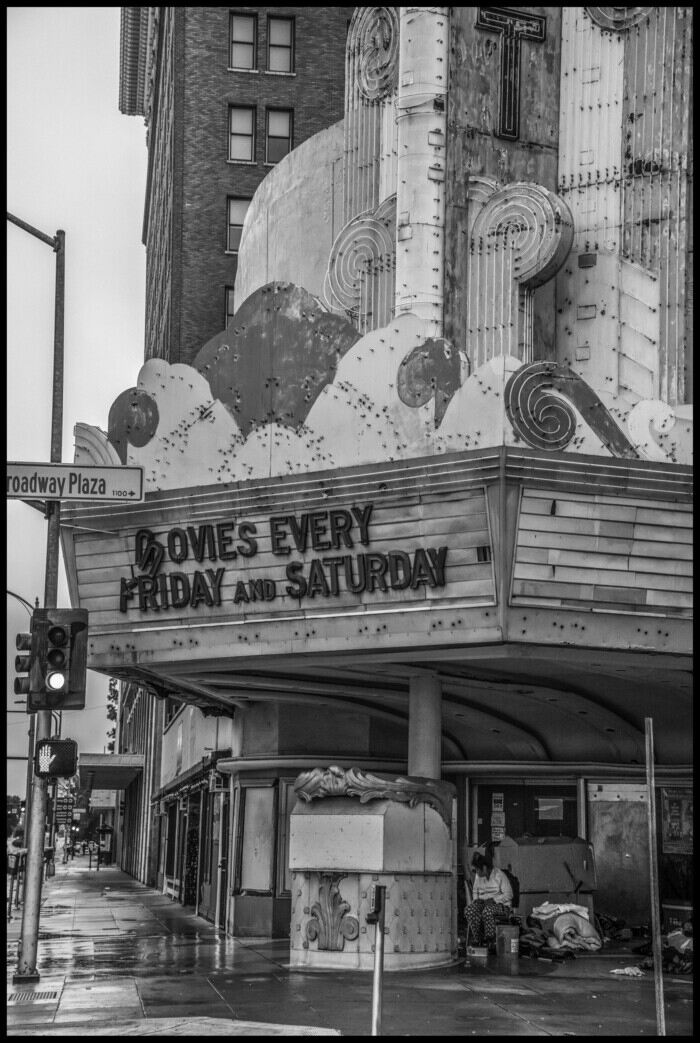
Unhoused people in Fresno take shelter under an old theater.(David Bacon)
EDITOR’S NOTE: This story was supported by a grant from the Economic Hardship Reporting Project.
Fresno, California—In the most productive agricultural area in the world, poverty is endemic. Crisscrossed by irrigation canals and railroad tracks, Fresno is the working-class capital and largest city of California’s San Joaquin Valley, a city where people speak Spanish as readily as English.
Here, the polarization of rich and poor is a constant theme in the city’s history and in its present. The banks and growers of the valley built ornate office buildings and movie palaces when the downtown was their showplace. Now, as developers have abandoned Fresno for the suburbs, the theater entrances and building doorways have become sleeping spaces and refuges from the rain for those with no fixed home.
Joseph and his partner sleep in a doorway downtown, stopped in front of the Azteca Theater on F Street.(David Bacon)
Fresno has one of the oldest Mexican barrios in California. Here, the abandonment is visible in closed theaters and dance halls, which leave their marquees as vestiges. Alongside them are small taquerias trying to survive. Today, the street in front of the Azteca Theater is hauntingly empty at night, but older residents remember when Cesar Chavez and a column of grape strikers stopped in front on F Street in 1966. The strikers were marching from Delano to Sacramento, and hundreds turned out to hear Chavez speak in the street outside.
Left: The Tecolote, or Owl, dance hall and cafe, in the old strip of clubs, bars and the Azteca Theater. Right: In a west Fresno garage, a Mixtec woman pours atole into cups for people coming early in the morning for her hometown's saints day.(David Bacon)
Bisecting downtown are the railroad tracks and the old Highway 99: a defining geography for the settlements of unhoused people. Community activists and the homeless people in the area have pressured a normally intransigent city government to provide at least enough housing to keep the dream of life off the streets alive. In 2019, Fresno had a larger percentage of “unsheltered” homeless people than any other city in the country—that is, people sleeping on sidewalks, in cars, or in places the government calls “not suitable for human habitation.”
Mike Rhodes, publisher of Community Alliance.(David Bacon)
People try to survive no matter their circumstances. In Fresno, they often win community support as they fight for living space in a hard, bare-knuckle city. Mike Rhodes cofounded Community Alliance, one of California’s longest-lived community newspapers, and spent 18 years denouncing the city for its abuse of homeless people.
Rhodes’s book, Dispatches from the War Zone, recounts the city’s many efforts over the years to drive encampments off the streets, and the community’s resistance. At one point he asked the city manager, “With about a thousand homeless people in the downtown area, and inadequate shelter space available, what is the city going to do with people who are homeless?” The community was given no answer about where people should go. Activists like Lisa Apper, with the Saint Benedict Catholic Worker, stood in front of the garbage trucks where people’s possessions would have been thrown, saying, “We have got to take a stand for justice.”
A woman crosses the tracks to the neighborhood where most of the unhoused people in Fresno live.(David Bacon)
Larry Collins has been on the streets for 10 years, and now lives in an apartment for homeless people at the Renaissance of Santa Clara.(David Bacon)
In a recent issue of Community Alliance, Bob McCloskey reports that city Homeless Assistance and Response Teams “relentlessly push [people] daily to move on with no place to go.” The city council turned down a proposal to allow people living on sidewalks in freezing temperatures to seek shelter in the city Convention Center. Gloria Wyatt told council members, “I am not used to being homeless, but I cannot cover rent. Our tent was torn down this morning, and we have no place to go. I am scared.”
Overhead the 99 freeway, the central artery of the San Joaquin Valley, runs next to the tracks, while under it two unhoused people make the journey back from downtown.(David Bacon)
Danny Alfiro burns paper in a trash basket to stay warm on a December night.(David Bacon)
In the downtown barrio next to the tracks, the Mexican bus station lists the towns in Mexico people might be returning to, and the towns in Washington State where they might be going to work.(David Bacon)
David BaconDavid Bacon is author of Illegal People—How Globalization Creates Migration and Criminalizes Immigrants (2008) and The Right to Stay Home (2013), both from Beacon Press. His latest book, about the US-Mexico border, More Than a Wall / Mas que un muro, is coming in May 2022 from the Colegio de la Frontera Norte.